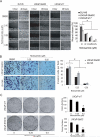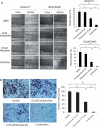Niclosamide suppresses cell migration and invasion in enzalutamide resistant prostate cancer cells via Stat3-AR axis inhibition
- PMID: 25970160
- PMCID: PMC4536195
- DOI: 10.1002/pros.23015
Niclosamide suppresses cell migration and invasion in enzalutamide resistant prostate cancer cells via Stat3-AR axis inhibition
Abstract
Purpose: It is known that over expression of IL6 in prostate cancer cells confer enzalutamide resistance and that this may occur through constitutive Stat3 activation. Additionally, recent pre-clinical studies suggested enzalutamide might have the potential adverse effect of inducing metastasis of prostate cancer cells via Stat3 activation. This study is aimed to target Stat3 activation and improve enzalutamide therapy.
Experimental design: Sensitivity of prostate cancer cells to enzalutamide was tested using cell growth assays and clonogenic assays. Wound healing and invasion assays were performed to determine cell migration and invasion in vitro. Quantitative reverse transcription-PCR, ELISA and Western blotting were performed to detect expression levels of PSA, c-Myc, survivin, Stat3, and AR. ChIP assay was performed to examine recruitment of AR to the PSA promoter.
Results: In the present study, we found niclosamide, a previously identified novel inhibitor of androgen receptor variant (AR-V7), inhibited Stat3 phosphorylation, and expression of downstream target genes. Niclosamide synergistically reversed enzalutamide resistance in prostate cancer cells and combination treatment of niclosamide with enzalutamide significantly induced cell apoptosis and inhibited cell growth, colony formation, cell migration and invasion. Knock down of Stat3 abrogated enzalutamide resistance resulting in reduced recruitment of AR to the PSA promoter in prostate cancer cells expressing IL6. Moreover, niclosamide reversed enzalutamide resistance by down-regulating Stat3 target gene expression Stat3and abrogating recruitment of AR to PSA promoter resulting in PSA inhibition.
Conclusions: This study demonstrated the IL6-Stat3-AR axis in prostate cancer is one of the crucial mechanisms of enzalutamide resistance. Niclosamide has the potential to target the IL6-Stat3-AR pathway to overcome enzalutamide resistance and inhibit migration and invasion in advanced prostate cancer.
Keywords: Stat3; enzalutamide; interleukin-6; niclosamide; prostate cancer.
© 2015 Wiley Periodicals, Inc.
Figures






Similar articles
-
Inhibition of constitutively active Stat3 reverses enzalutamide resistance in LNCaP derivative prostate cancer cells.Prostate. 2014 Feb;74(2):201-9. doi: 10.1002/pros.22741. Epub 2013 Oct 16. Prostate. 2014. PMID: 24307657 Free PMC article.
-
Niclosamide and Bicalutamide Combination Treatment Overcomes Enzalutamide- and Bicalutamide-Resistant Prostate Cancer.Mol Cancer Ther. 2017 Aug;16(8):1521-1530. doi: 10.1158/1535-7163.MCT-16-0912. Epub 2017 May 12. Mol Cancer Ther. 2017. PMID: 28500234 Free PMC article.
-
Niclosamide inhibits androgen receptor variants expression and overcomes enzalutamide resistance in castration-resistant prostate cancer.Clin Cancer Res. 2014 Jun 15;20(12):3198-3210. doi: 10.1158/1078-0432.CCR-13-3296. Epub 2014 Apr 16. Clin Cancer Res. 2014. PMID: 24740322 Free PMC article.
-
Prostate cancer: AR aberrations and resistance to abiraterone or enzalutamide.Nat Rev Urol. 2016 Dec;13(12):697-698. doi: 10.1038/nrurol.2016.212. Epub 2016 Nov 2. Nat Rev Urol. 2016. PMID: 27804988 Review. No abstract available.
-
Targeting the androgen receptor in prostate cancer.Expert Opin Pharmacother. 2014 Jul;15(10):1427-37. doi: 10.1517/14656566.2014.915313. Epub 2014 Jun 2. Expert Opin Pharmacother. 2014. PMID: 24890318 Review.
Cited by
-
Preferential Inhibition of Wnt/β-Catenin Signaling by Novel Benzimidazole Compounds in Triple-Negative Breast Cancer.Int J Mol Sci. 2018 May 20;19(5):1524. doi: 10.3390/ijms19051524. Int J Mol Sci. 2018. PMID: 29783777 Free PMC article.
-
Adaptive pathways and emerging strategies overcoming treatment resistance in castration resistant prostate cancer.Asian J Urol. 2016 Oct;3(4):185-194. doi: 10.1016/j.ajur.2016.08.001. Epub 2016 Aug 22. Asian J Urol. 2016. PMID: 28642838 Free PMC article.
-
Wnt Signaling in Leukemia and Its Bone Marrow Microenvironment.Int J Mol Sci. 2020 Aug 28;21(17):6247. doi: 10.3390/ijms21176247. Int J Mol Sci. 2020. PMID: 32872365 Free PMC article. Review.
-
Emerging data on androgen receptor splice variants in prostate cancer.Endocr Relat Cancer. 2016 Dec;23(12):T199-T210. doi: 10.1530/ERC-16-0298. Epub 2016 Oct 4. Endocr Relat Cancer. 2016. PMID: 27702752 Free PMC article. Review.
-
Personalized regulation of glioblastoma cancer stem cells based on biomedical technologies: From theory to experiment (Review).Int J Mol Med. 2018 Aug;42(2):691-702. doi: 10.3892/ijmm.2018.3668. Epub 2018 May 10. Int J Mol Med. 2018. PMID: 29749540 Free PMC article. Review.
References
-
- Scher HI, Fizazi K, Saad F, Taplin ME, Sternberg CN, Miller K, et al. Increased survival with enzalutamide in prostate cancer after chemotherapy. N Engl J Med. 2012;367:1187–97. - PubMed
-
- Lin TH, Lee SO, Niu Y, Xu D, Liang L, Li L, et al. Differential androgen deprivation therapies with anti-androgens casodex/bicalutamide or MDV3100/Enzalutamide versus anti-androgen receptor ASCJ9(R) Lead to promotion versus suppression of prostate cancer metastasis. The Journal of biological chemistry. 2013;288:19359–69. - PMC - PubMed
-
- Lin TH, Izumi K, Lee SO, Lin WJ, Yeh S, Chang C. Anti-androgen receptor ASC-J9 versus anti-androgens MDV3100 (Enzalutamide) or Casodex (Bicalutamide) leads to opposite effects on prostate cancer metastasis via differential modulation of macrophage infiltration and STAT3-CCL2 signaling. Cell death & disease. 2013;4:e764. - PMC - PubMed
Publication types
MeSH terms
Substances
Grants and funding
LinkOut - more resources
Full Text Sources
Other Literature Sources
Medical
Research Materials
Miscellaneous

